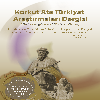Libya'nın Dört Farklı Bölgesinin Rüzgâr Enerji Potansiyelinin Weibull Dağılımı ile İncelenmesi
INVESTIGATION OF WIND ENERGY POTENTIAL OF FOUR DIFFERENT SITES OF LIBYA BY USING WEIBULL DISTRIBUTION
___
- [1] Ansari, M., 2018, "Libyan oil: Prospects for stability and growth", Apicorp Energy Research, Vol. 3, No. 14, pp. 1–4.
- [2] Morrow, S., "Blockade will halve Libya oil output: National Oil Co.", https://www.aa.com.tr/en/energy/oil/blockade-will-halve-libya-oil-output-national-oil-co/29834, access date: February 18, 2021.
- [3] St John, R.B., 2008, "The changing Libyan economy: Causes and consequences", The Middle East Journal, Vol. 62, No. 1, pp. 75–91.
- [4] Khalil, A., Asheibi, A., " The chances and challenges for renewable energy in Libya", 4th International Conference on Renewable Energy Research and Applications, Palermo, Italy, 1-6, November 22-25, 2015.
- [5] Mrehel, O.G., Gerara Salama, A., "Energy generation potential from wind power in the Southern Libyan Regions", 2021 IEEE 1st International Maghreb Meeting of the Conference on Sciences and Techniques of Automatic Control and Computer Engineering MI-STA, 548–553, Tripoli, Libya, May 25-27, 2021.
- [6] Elmnifi, M., Alshilmany, M., Abdraba, M., 2018, "Potential of municipal solid waste in Libya for energy utilization", Open Journal of Mechanical Engineering, Vol. 2, No. 1, pp. 1–5.
- [7] Kutucu, H., Almryad, A., "Modeling of solar energy potential in Libya using an artificial neural network model", 2016 IEEE First International Conference on Data Stream Mining & Processing (DSMP), 356–359, Lviv, Ukraine, August 23-27, 2016.
- [8] Belgasim, B., Aldali, Y., Abdunnabi, M.J.R., Hashem, G., Hossin, K., 2018, "The potential of concentrating solar power (CSP) for electricity generation in Libya", Renewable and Sustainable Energy Reviews, Vol. 90, pp. 1–15.
- [9] Mohamed, O.A., Masood, S.H., 2018, "A brief overview of solar and wind energy in libya: Current trends and the future development", IOP Conference Series: Materials Science and Engineering, Vol. 377, No. 1, 1-12.
- [10] Nassar, Y.F., Salem, M.A., Iessa, K.R., AlShareef, I.M., Ali, K.A., Fakher, M.A., 2021, "Estimation of CO2 emission factor for the energy industry sector in libya: a case study", Environment, Development and Sustainability, doi: 10.1007/s10668-021-01248-9.
- [11] Mohamed, A.M.A., Al-Habaibeh, A., Abdo, H., 2013, "An investigation into the current utilisation and prospective of renewable energy resources and technologies in Libya", Renewable Energy, Vol. 50, pp. 732–740.
- [12] Mentis, D., Hermann, S., Howells, M., Welsch, M., Siyal, S.H., 2015, "Assessing the technical wind energy potential in Africa a GIS-based approach", Renewable Energy, Vol. 83, No. 7, pp. 110–125.
- [13] El-Osta, W., Belhag, M., Klat, M., Fallah, I., Kalifa, Y., 1995, "Wind farm pilot project in Libya", Renewable Energy, Vol. 6, No. 5-6, pp. 639–642.
- [14] Kassem, Y., Çamur, H., Aateg, R.A.F., 2020, "Exploring solar and wind energy as a power generation source for solving the electricity crisis in Libya", Energies, Vol. 13, No. 14, 3708.
- [15] Schafer, I., "The renewable energy sector and youth employement in Algeria, Libya, Morocco and Tunisia", https://www.afdb.org/fileadmin/uploads/afdb/Documents/Publications/The_Renewable_Energy_S ector_and_Youth_Employment_in_Algeria__Libya__Morocco_and_Tunisia.pdf, access date: February 18, 2021.
- [16] Elmabruk, A.M., Aleej, F.A., Badii, M.M., "Estimation of wind energy in Libya", 5th International Renewable Energy Congress (IREC), 1-6, Hammamet, Tunisia, March 25-27, 2014.
- [17] Hasan, S.H.A., Guwaeder, A., Gao, W., 2017, "Wind energy assessment of the Zawiya Region, in northwest Libya", Energy and Power Engineering, Vol. 09, No. 06, pp. 325–331.
- [18] Kassem, Y., Çamur, H., AbuGharara, M.A., 2019, "Assessment of wind energy potential for selecting small-scale wind turbines in low wind locations in Libya: A comparative study", International Journal of Engineering Research and Technology, Vol. 12, No. 6, pp. 820–836.
- Yayın Aralığı: Yılda 4 Sayı
- Yayıncı: Konya Teknik Üniversitesi, Mühendislik ve Doğa Bilimleri Fakültesi
TÜRKİYE'DEKİ KELEBEK TÜRLERİNİN BASAMAKLI EVRİŞİMLİ SİNİR AĞLARI İLE SINIFLANDIRILMASI
Mete KALYONCU, Onur ESER, Abdullah ÇAKAN, Fatih Mehmet BOTSALI
HAŞHAŞ TOHUM (Papaver somniferum L.) YAĞININ BİYODİZEL YAKIT ÖZELLİKLERİNİN BELİRLENMESİ
Hülya DOĞAN, Tanzer ERYILMAZ, Selen ALNIAK SEZER, Belgin COŞGE ŞENKAL, Tansu USKUTOĞLU, Cüneyt CESUR
SPORCULARIN KALP ATIM HIZININ ESP-NOW KULLANILARAK KABLOSUZ İLETİMİ
Ahmet AYDIN, Ömer Muhsin DÜNDAR
Hakan ACAROĞLU, Burcu YÜRÜK, Atabak NAJAFI, Ömer KARA
Libya'nın Dört Farklı Bölgesinin Rüzgâr Enerji Potansiyelinin Weibull Dağılımı ile İncelenmesi
Selcuk SELİMLİ, Mehmet OZKAYMAK, Abdel Karim FAHED, Fauzi Ammar Ahmed SHTEWI, Çagıl Yaman KOYMATCIK
GRAFİT KATKILI SİKLO-OLEFİN KOPOLİMER (COC) KOMPOZİTLERİN TRİBOLOJİK ÖZELLİKLERİNİN İNCELENMESİ
Salih Hakan YETGİN, İbrahim KILINÇ
BATMIŞ HİDROLİK SIÇRAMADA GERİ DÖNÜŞ BÖLGESİ UZUNLUĞUNUN YAPAY ZEKÂ YÖNTEMLERİYLE TAHMİNİ
Oğuz ŞİMŞEK, Veysel GÜMÜŞ, Nazire Göksu SOYDAN OKSAL, İbrahim Mahmut YOLUK
